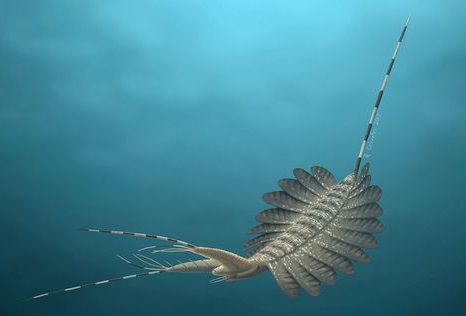
Five-hundred-and-twenty-million years ago, a primitive and bizarre sea-predator known as Kerygmachela kierkegaardiroamed the seas in what is now North Greenland. The ancient arthropod—invertebrate animals with an exoskeleton and segmented body—had 11 pairs of flaps for swimming, two long appendages on its head and a long, spiky tail.
But it's another aspect of the animal's strange anatomy that has been the focus of a new study published in the Nature Communications journal.
In the paper, Jakob Vinther—a lecturer in Macroevolution at the University of Bristol—and colleagues, describe the discovery of 15 fossilized K. kierkegaardi brains, which were found in North Greenland during expeditions conducted in 2011, 2016 and 2017.
Not only are the half-billion-year-old, well-preserved brains some of the oldest ever found, but they also shine a light on the evolutionary history of the organ in animals.
The researchers found the brain of K. kierkegaardi is composed of just a single segment unlike the more complex human brain—which has two segments—or the three-segmented brains of the animal's distant arthropod relatives—such as spiders, butterflies and lobsters.
This contradicts what many scientists previously thought: that the ancestor of all vertebrates and arthropods had brains with three segments.
The findings show that the "animal brain evolved to become large and complex" in independent sectors of the animal kingdom—arthropods and vertebrates, for example—Vinther told Newsweek.
K. kierkegaardi's primitive eyes also provide intriguing insights into arthropod evolution, researchers said.
"[Its eyes] form an intermediate step between more-simple eyes in [modern] distant relatives, such as velvet worms and water bears [also called tardigrades], and the very, very complex eyes of arthropods," which sometimes sit on the end of eyestalks, Vinther told LiveScience.
K. kierkegaardi lived shortly after an event known as the Cambrian explosion—which took place roughly 541 million years ago—when most major animal groups that we see today began to appear.
Uncommon Knowledge
Newsweek is committed to challenging conventional wisdom and finding connections in the search for common ground.
Newsweek is committed to challenging conventional wisdom and finding connections in the search for common ground.
About the writer
Aristos is a Newsweek science reporter with the London, U.K., bureau. He reports on science and health topics, including; animal, ... Read more
To read how Newsweek uses AI as a newsroom tool, Click here.








